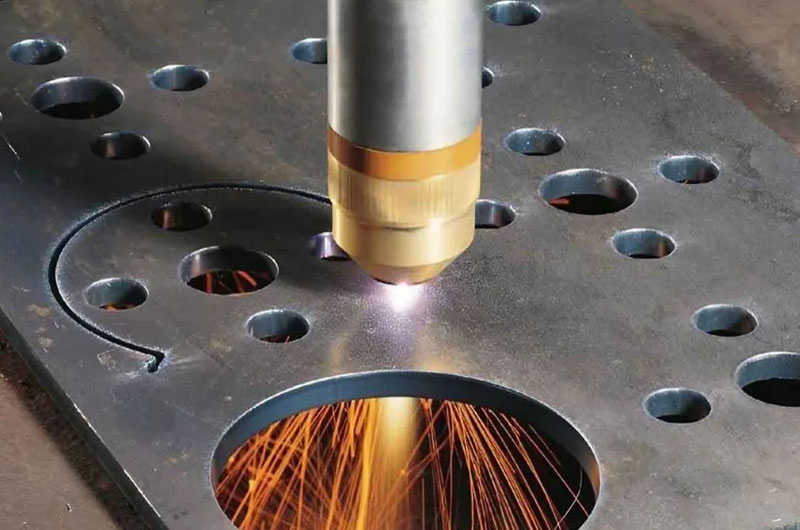Sheet metal is a fundamental material in manufacturing. One of the critical aspects of working with sheet metal is the cutting process, which must be tailored to the thickness of the material.
Thin and thick sheet metals each present unique challenges and considerations, from equipment selection and cutting methods to quality control and cost efficiency.
1. Understanding Sheet Metal Thickness
Sheet metal thickness is typically measured in gauge (imperial) or millimeters (metric). In general:
- Thin sheet metal ranges from 30 gauge (~0.3 mm) to 14 gauge (~2 mm).
- Thick sheet metal is generally considered anything thicker than 2 mm, extending up to 20 mm or more.
The thickness of sheet metal directly influences the cutting method, equipment requirements, edge quality, production speed, and overall cost.
2. Cutting Methods for Thin Sheet Metal

Laser Cutting
Laser cutting offers exceptional precision and efficiency for slicing thin sheet metal. It uses a concentrated laser beam to melt or vaporize the material, resulting in clean edges with very narrow kerf widths.
- Advantages: High accuracy, minimal distortion, narrow kerf, and smooth finishes.
- Best for: Mild steel, stainless steel, aluminum up to ~6 mm thickness.
Shearing
Shearing involves using a straight-blade shear to cut metal in a linear motion.
- Advantages: Fast, economical, and ideal for high-volume production.
- Limitations: Not suitable for complex shapes; can cause slight deformation on very thin materials.
Waterjet Cutting
Thin metals can be cut using a high-pressure water jet, which is often combined with abrasive particles to enhance cutting performance.
- Advantages: No heat-affected zone (HAZ), precise, and good for reflective or heat-sensitive materials.
- Drawbacks: Slower than laser cutting and more expensive in terms of operating costs.
Punching
CNC turret punching is commonly used for perforating thin sheet metal.
- Advantages: Rapid production for repetitive shapes and patterns.
- Ideal for: Electrical panels, ventilation grills, and enclosures.
3. Cutting Methods for Thick Sheet Metal

Plasma Cutting
Plasma cutting employs a high-speed jet of ionized gas to melt the metal and blow it away from the cut area. It is ideal for cutting thick sheets and plates.
- Advantages: Fast cutting speed, effective on conductive metals, and capable of cutting up to 50 mm thick steel.
- Drawbacks: Larger kerf, more dross, and moderate precision compared to laser.
Oxy-Fuel Cutting
This method involves a chemical reaction between oxygen and a fuel gas (such as acetylene) to cut thick carbon steel.
- Advantages: Very effective for cutting carbon steels thicker than 20 mm.
- Drawbacks: High heat input, not suitable for stainless steel or non-ferrous metals.
Heavy-Duty Laser Cutting
Industrial fiber lasers can cut stainless steel and aluminum up to 20–25 mm.
- Advantages: Excellent edge quality, high precision.
- Limitations: More expensive machinery and higher energy consumption.
Waterjet Cutting (Abrasive)
Waterjet is also effective for thick materials, especially when edge quality and material integrity are priorities.
- Advantages: No thermal distortion, suitable for thicknesses up to 150 mm.
- Limitations: Slower cutting speed, higher operational cost.
4. Edge Quality and Finish
- Thin Sheet Metal: Laser and shearing produce smooth, clean edges. The minimal material thickness means less post-processing, such as deburring.
- Thick Sheet Metal: Plasma and oxy-fuel cutting can result in rough edges and slag, requiring more grinding or finishing operations. Abrasive waterjet and fiber laser cutting yield better finishes but may be costlier.
5. Heat-Affected Zone (HAZ)
- Thin Sheets: Prone to warping and discoloration if the heat is not well controlled. Laser cutting minimizes HAZ due to its focused beam.
- Thick Sheets: The HAZ is more substantial, especially in plasma or oxy-fuel cutting. This can affect material strength and may require thermal post-treatment.
6. Material Types and Suitability
| Cutting Method | Thin Sheets (≤2 mm) | Thick Sheets (≥2 mm) |
|---|---|---|
| Laser Cutting | Excellent for all metals | Effective up to 20–25 mm |
| Plasma Cutting | Acceptable above 1.5 mm | Ideal for 3–50 mm conductive metals |
| Oxy-Fuel Cutting | Not suitable | Excellent for thick carbon steel |
| Waterjet Cutting | Ideal for precise cuts | Great for thick, sensitive materials |
| Shearing | Best for simple, linear cuts | Not ideal for thick sheets |
| Punching | Good for repetitive patterns | Not effective above 4 mm |
7. Speed and Production Efficiency
- Thin Sheet Metal: Faster to cut using laser, shear, or punching. Automation and CNC systems enhance throughput significantly.
- Thick Sheet Metal: Slower processes, particularly with waterjet or oxy-fuel. Plasma offers a balance between speed and cost.
8. Tooling and Equipment Considerations
- Thin Metal: Requires high precision machines, sharp tools, and precise control to avoid distortion.
- Thick Metal: Demands more power, heat-resistant equipment, and often multiple passes or preheating (especially in oxy-fuel cutting).
9. Cost Comparison
- Thin Metal Cutting:
- Laser cutting: Cost-effective for small to medium batches.
- Shearing and punching: Economical for mass production.
- Thick Metal Cutting:
- Plasma and oxy-fuel: Lower cost per cut for heavy-duty applications.
- Waterjet and fiber laser: Higher cost, justified by better edge quality and material compatibility.
10. Applications
- Thin Sheet Metal: Used in automotive body panels, HVAC components, enclosures, kitchen appliances, and electronics.
- Thick Sheet Metal: Applied in heavy equipment manufacturing, shipbuilding, bridges, structural frameworks, and industrial machinery.

